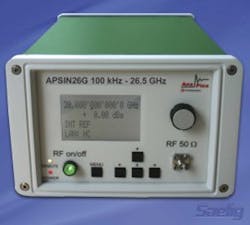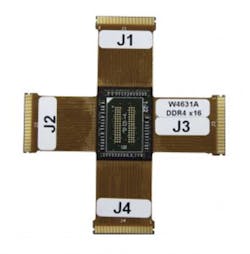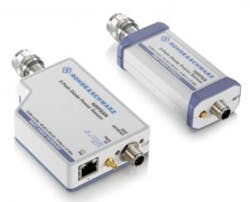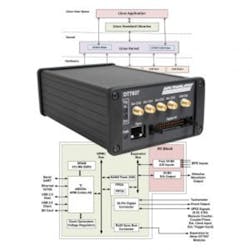The APSIN26G low-noise microwave signal generator covers 100 kHz to 26 GHz. It provides microHertz frequency resolution, a wide and accurately flat output power range to +20 dBm, and low spurious levels. Comprehensive AM, low-distortion, wideband DCFM, and high-speed pulse modulation allow for testing a range of receivers. The APSIN26G features a 400-μs frequency switching time as well as low SSB phase noise. A stable temperature-compensated 100-MHz reference (OCXO) ensures minimal drift, but it can be phase-locked to almost any stable external reference in a range from 1 MHz to 250 MHz.
The APSIN26G’s trigger and sweeping modes can be controlled via standard interfaces such as USB-TMC, LAN, and GPIB and can operate from an optional internal rechargeable battery for portable use. The instrument is manufactured by Swiss company AnaPico AG. Saelig
A new ball grid array interposer for testing DDR4 x16 DRAM designs with a logic analyzer provides fast, accurate capture of address, command, and data signals for debugging designs and making validation measurements. The W4631A BGA interposer is used with the vendor’s E5849A probes for high-data-rate DDR4 DRAM designs. It is designed for data rates up to 3.2 Gb/s. The probes are used with the U4154B logic analyzer to perform functional tests.
The DDR4 x16 DRAM probing capability can be ordered now with prices starting at $10,316. The complete U4154B logic analyzer system for probing DDR4 x16 DRAM starts at $97,673. Keysight Technologies
The R&S NRPxxS and R&S NRPxxSN USB three-path diode power sensors offer improved measurement speed and measurement accuracy, even at low levels. The R&S NRPxxSN model features both a USB and a LAN interface. Both power sensor models are available for three frequency ranges from 10 MHz to 8 GHz, to 18 GHz, and to 33 GHz.
The R&S NRPxxS/SN sensors enable 10,000 triggered measurements per second with a minimum trigger resolution of 100 µs. A special mode permits in excess of 50,000 equidistant measurements per second. The improved three-path diode design makes it possible to decrease the lower measurement limit to -70 dBm. Rohde & Schwarz
The IQC91000A RF and microwave signal recording and playback system can capture, digitize, and store up to 1,000 MHz of the electromagnetic spectrum in real time. It does so without gaps and missed signal events within any frequency range from 500 MHz to 18 GHz with 50 dB of spurious-free dynamic range.
The entire 1,000-MHz signal-capture file or selected portions of it can be regenerated and played back at virtually any desired center frequency and offloaded at high speed to a workstation for analysis. The IQC91000A is suited for signals intelligence and electronic intelligence applications, interference detection, and testing and validation of radar, electronic warfare, and commercial and military wireless communications systems. X-COM Systems
Multiplexed SAR ADC
The LTC2373-18, an eight-channel, 18-bit, 1-MS/s successive-approximation-register (SAR) ADC with 100-dB SNR performance, is equipped with a programmable sequencer that can store up to 16 control words for configuring the multiplexer (MUX) and input range. This provides the ability to easily mix and match fully differential and pseudo-differential input ranges with a variety of MUX channel configurations.
Single-ended input signals also may be converted to the fully differential input range of the ADC core by sharing a single external driver circuit between the MUXOUT/ADCIN pins available on the device. This enables the user to achieve the full 100-dB SNR performance of the ADC on eight single-ended inputs. Linear Technology
Vibration Measurement Module
The DT7837 ARM-based dynamic signal analyzer module for noise and vibration measurement includes a computer portion that uses a ruggedized BeagleBone Black ARM processor. To assist OEM users, complete source code is provided that can be modified and
used without any restrictions. Further examples show how to develop an embedded application for a specific purpose using various open-source libraries and utilities.
The front-end design of the DT7837 allows simultaneous measurement of four 24-bit IEPE sensor inputs at a sampling rate of 102.4 kS/s. The module is suitable for precision measurements with microphones, accelerometers and other transducers that have a large dynamic range. Common applications include audio, acoustic, and vibration testing. Data Translation
Protocol Test Suite
The enhanced SIP Protocol Test Suite comprises the MAPS SIP, the MAPS SIP I, and the MAPS SIP Conformance Test Suite. It simulates any interface in a SIP (Session Initiation Protocol) network, including multiple user agents (user agent client, user agent server), registrant, proxy, redirect, and registrar servers.
MAPS SIP also is available in an enhanced high-density version in a special-purpose 1U network appliance that is capable of high call intensity (hundreds of calls per second) and a high volume of sustained calls (tens of thousands of simultaneous calls/1U platform). MAPS SIP I can simulate the SIP-ISUP signaling specification as defined by the ITU/IETF standards ITU-T Q.1912.5. GL Communications
High-Speed-PCB Material
Chronon is the vendor’s latest ultra-low loss, high-speed laminate and prepreg material engineered to mitigate skew issues in high-speed designs that have differential pairs. The introduction of Chronon, which follows the 2014 launch of Gigasync, expands the company’s portfolio of PCB materials.
Independent testing has confirmed the capability of Chronon materials to reduce weave-induced skew. Skew caused by the glass-weave effect can be as high as 130 ps when trace lengths exceed 20 inches. Using test vehicles from Speeding Edge, an independent consultant to the PCB industry, the maximum skew on a horizontal 14-inch trace using Chronon materials was 5 ps. Isola Group
Embedded Test Suite
VectorCAST 6.3 embedded test suite for Internet of Things (IoT) and machine-to-machine (M2M)
implementations provides a new micro-harness architecture designed for the smaller microprocessors and limited resources often available in IoT and M2M applications.
Beyond the new harness architecture, VectorCAST 6.3 offers several enhancements for test collaboration, change-based testing, and massively parallel testing. These features make it simple for teams to leverage test cases and test results across the enterprise.
Each developer can quickly and independently test their code changes by running only those tests affected by the source code changes that were made; this leads to improved software quality with reduced test cycle times. Vector Software





